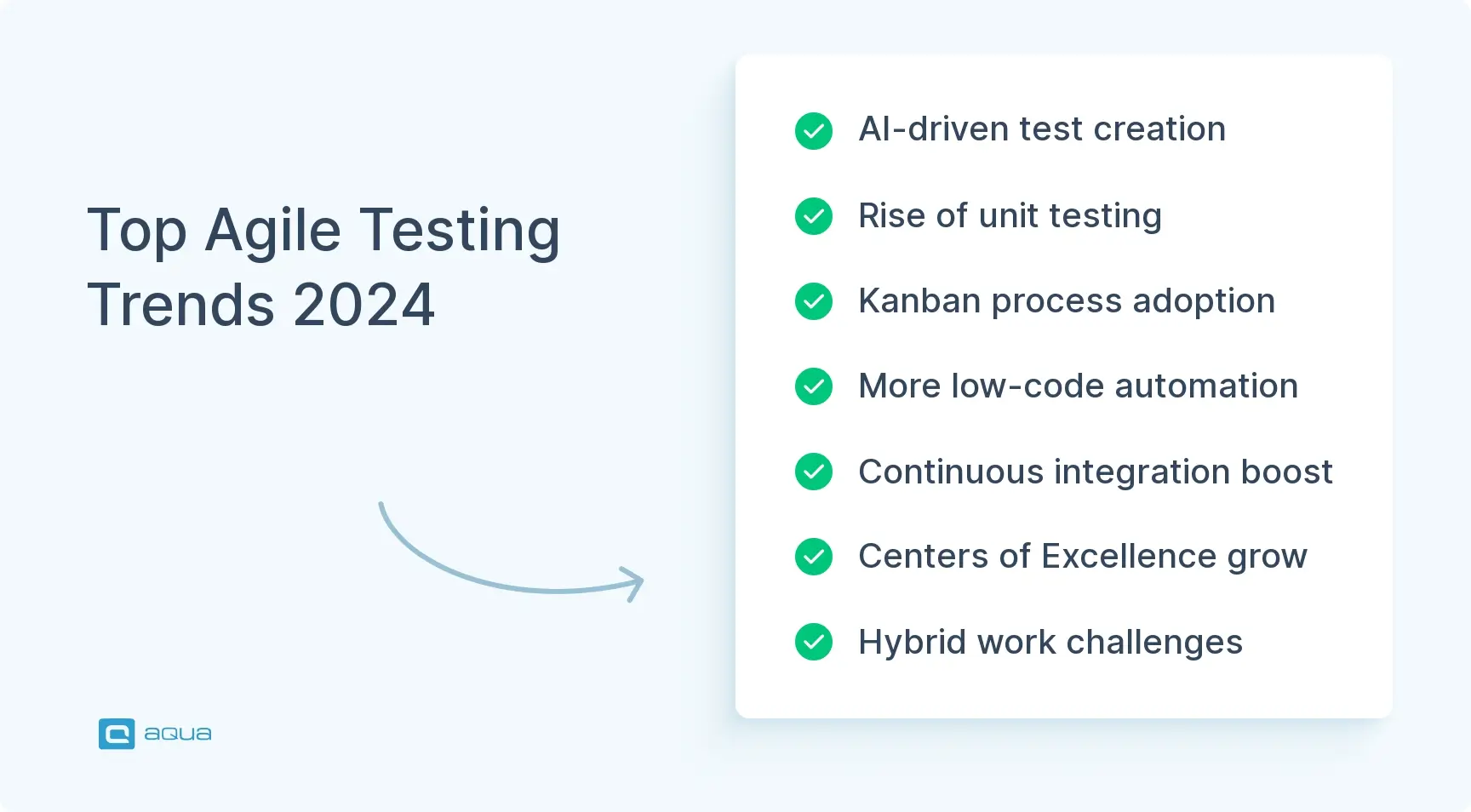Just to be on the same page, Agile testing is the approach to Quality Assurance that extends the principles of Agile software development to testing. We have looked into this in more detail in our separate agile testing vs traditional testing overview. These days, most companies run their testing the modern way, so don’t be surprised if some of the Agile testing trends below don’t have to do much with textbook Agile fundamentals.
We also discussed other tendencies in the video:
What is Agile testing?
Agile testing is an approach where testing activities run parallel to the development process. It’s all about flexibility, collaboration, and constant adaptation. Unlike traditional methods, where testing happens after the development phase, Agile testing integrates testing throughout the entire development cycle.
According to industry surveys, teams practising Agile methodologies experience a 20%-50% reduction in time-to-market compared to traditional approaches. It helps you make quick adjustments, provide continuous feedback, and have the ability to respond swiftly to changes or updates.
Agile testing innovation shines in today’s fast-paced tech world, where being quick and adaptable is super important. It helps you ensure software gets checked bit by bit as you make it, letting your team quickly adjust to changes. This way, you can create top-notch products that fit your users’ needs.
Trailblazing AI automation
AI automation is taking over at lightning speed. Nearly a quarter of teams now use AI to write test scenarios, while others throw AI at everything from visual regression checks to debugging headaches.
Teams are plugging AI straight into their CI/CD pipelines for instant feedback. The productivity bump is significant enough that most teams can’t imagine going back.
You need to pick one repetitive testing task, maybe data generation or basic regression checks, and experiment with an AI tool for two weeks. You’ll quickly see why IDC predicts three-quarters of enterprises will lean heavily on AI-powered testing by next year.
So AI doesn’t just speed things up, it often catches edge cases human testers miss entirely.
AI-powered QA solution to generate tests from requirements or plain English
Adopting unit testing
Agile is about flexibility and delivering iteratively, and unit testing fits that perfectly. You can avoid hassle for both development and QA if devs make their own simple tests. They would usually run the tests themselves to find obvious issues and immediately fix them before shipping the code to QA. While setting up unit tests is extra work for devs and might require QA’s involvement, you’ll save much more time even in the short run.
The Shift-Left Approach: Test Early and Often
Here’s a trend that’s reshaping how smart teams approach quality: shift-left testing. Instead of waiting until later stages to catch bugs, you’re moving QA activities right into the design and coding phases. The payoff is huge, and you might find defects before they become expensive headaches. This isn’t just about finding bugs faster. You’re building a mindset where everyone owns quality from day one.
Have your developers write tests alongside their code, or get QA folks involved in requirement reviews. The real magic happens when your whole team starts thinking ‘how might this break?’ before the feature even exists.
One concrete step you can take tomorrow: institute 15-minute ‘quality check-ins’ during your daily standups where someone shares what they tested or what assumptions they validated. You’ll see faster releases without the usual scramble at the end, because quality becomes automatic rather than an afterthought.
Moving on to Kanban
While a lot of companies take the Scrum in agile testing route, some take things further. Regular sprint intervals can feel pretty restrictive to product owners, and you certainly won’t want QA to become the bottleneck if devs can match a faster pace. Adopting the Kanban flow of getting things done ASAP is a tech team-wide effort, one that can’t happen without testers on board. We have made the move and now add release features to aqua 300% faster.
Scaling up test automation
CI/CD is table stakes. Your testing role has shifted from gatekeeper to pipeline architect, and here’s the thing most teams miss: the real power lies in those AI-driven failure predictions.
Teams using intelligent failure detection report deployment confidence that’s nearly doubled compared to traditional approaches. The sweet spot lies in configuring alerts for patterns, not just failures and then you’ll catch issues before they cascade.
But don’t automate everything at once. Pick your most painful manual test first, automate it well, then expand. Your feedback loops will tighten naturally, and releases become less of a nail-biter and more of a victory lap.
Exploring low-code test automation
Compared to writing software, low-code test automation is a surprisingly underrepresented subset. It won’t take you many fingers to list all low-code solutions that specialise in quality assurance. This does feel like a missed opportunity, because there are certainly use cases to lower the technical entry barrier for people with the QA mindset. Perhaps OpenAI’s GPT model will make it more attractive for vendors to prototype a QA-specialised low-code test automation tool.
Stepping up Continuous Integration
In terms of team-wide time savers, Agile testing and DevOps trends go hand in hand. There is hardly any better way to save time yet maintain (or increase) quality than adopting a continuous integration pipeline. The less human factor and idle time you have, the more polish and speed you add to your software releases.
Continuous Testing: The Heartbeat of Agile Delivery
Continuous testing has become the cornerstone of modern Agile delivery – and you’ll want to weave it deep into your development process. Every code change gets validated automatically and efficiently throughout the SDLC, creating feedback loops that catch issues before they even think about reaching production. Teams that excel at this embed quality checks everywhere – unit tests, API validations, UI testing, security scans. The whole works.
When you adopt ‘shift-left’ thinking and integrate these tests directly into your CI/CD pipelines, you’ll see the real benefits. Pick one test type and automate it completely before adding others. This approach transforms how quickly you can release without breaking things.
With comprehensive continuous testing, deployment frequencies can nearly double, plus customer satisfaction scores that consistently trend upward. You get the flexibility to adapt in real time – something that’s pretty much non-negotiable these days.
Setting up Testing Center of Excellence
Standardising QA processes may seem straightforward enough, but things get much more difficult with multiple projects. The vanilla approach is making a practical test strategy document that can be supplemented by a high-level test policy if needed. A more complex and large-scale answer is the Testing Center of Excellence, which would allocate QA resources between different teams and govern how they use it. Good tech specialists are still hard to come by, so big companies will find value in optimising the work of people they already have.
Visualising the QA effort
When it comes to fixing defects, reproducing them can be a real challenge. Whether it’s unclear bug reports or genuinely confusing issues, having a visual goes a long way. Both major players and emerging companies started releasing test recorders to facilitate troubleshooting. The idea is to capture test execution and supplement the test report with video and/or relevant screenshots. Some tools go as far as capturing DevTools logs and transcribing all tester’s inputs. This is simple yet promising tech that will ideally extend beyond testers and devs.
We too have created a tool to make bug reports visual and straightforward. It integrates well with issue management solutions but can also be used independently. Click this link to get a beta version of Capture.
Extending metrics to QA
Given the recession, companies absolutely will try to make the most of what they have while finding a new competitive edge. Giving extra attention to the quality assurance team is the obvious choice for higher-ups. Internal metrics are fine, but it is external metrics that will tell how the QA effort (or lack of it) helps a company acquire and retain customers as consumer spending goes down.
Handling hybrid work
The least technical trend on our list, hybrid work is a prominent example of how non-technical things affect the QA output. An increasing number of companies, especially in the US, take a turn from pandemic-prompted remote work to a hybrid approach. The same tech people will be working in the office and at home. These people will not always be working in the office and at home on the same day. The hybrid model will require extra effort when it comes to documentation, written communication, and process formalisation.

Conclusion
The Agile testing trends for 2024 overall paint an optimistic future. QA specialists will be able to test faster, improve communication with devs, and release even more polished software in an increasingly competitive market. We are excited to see where the next year takes testing.
Kick off your year with a forward-looking test management solution

















